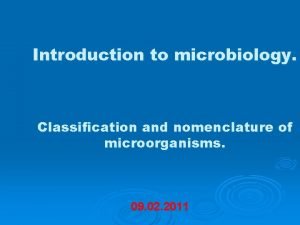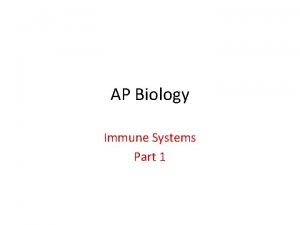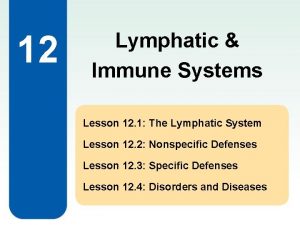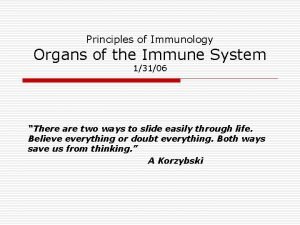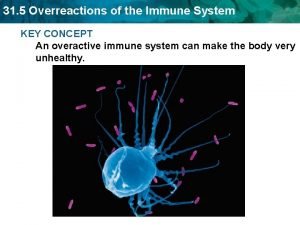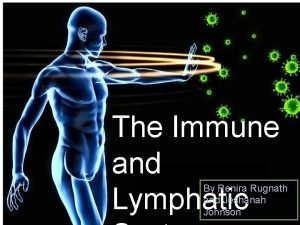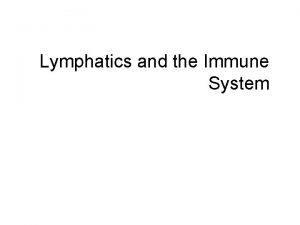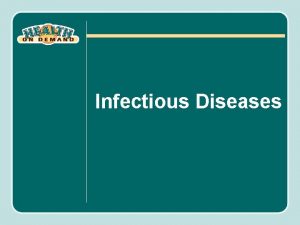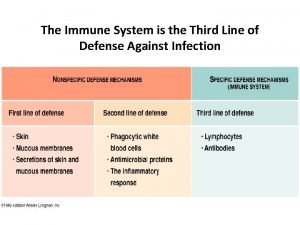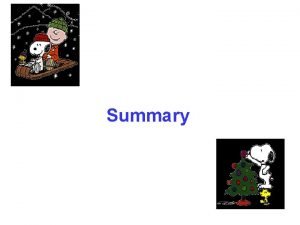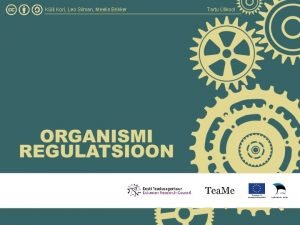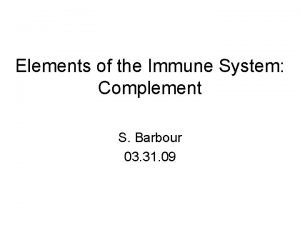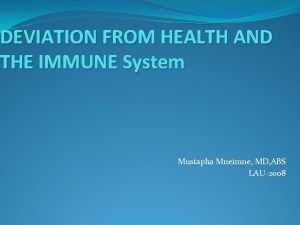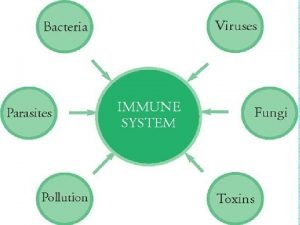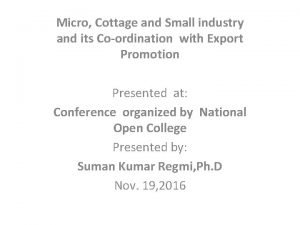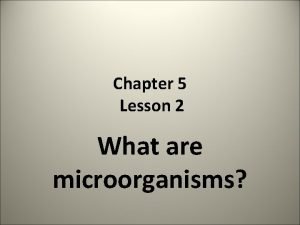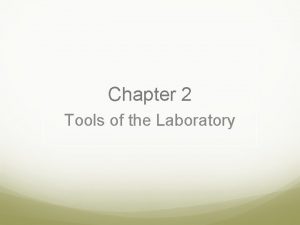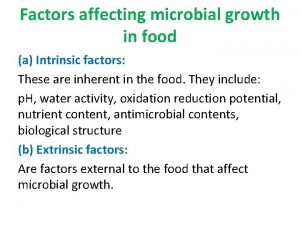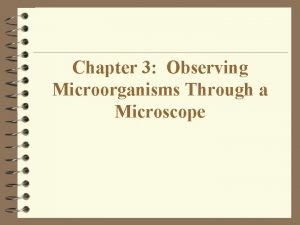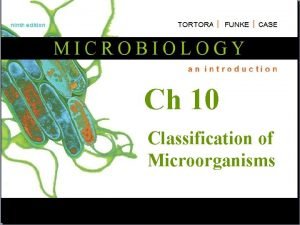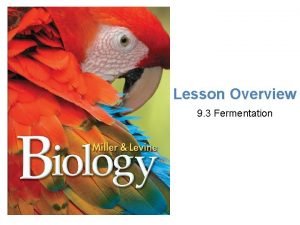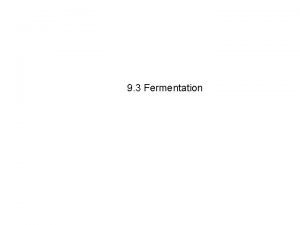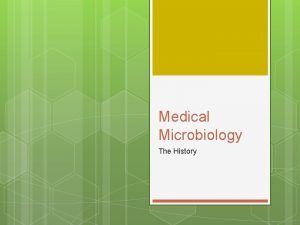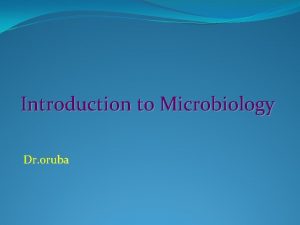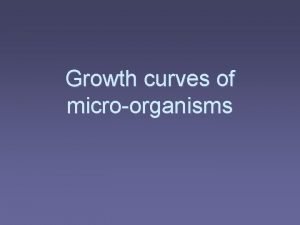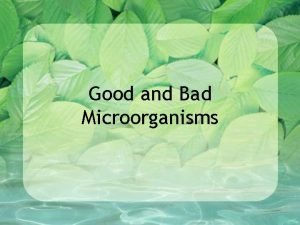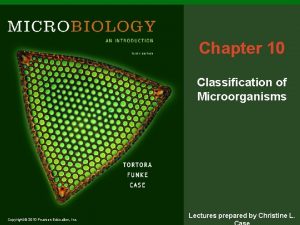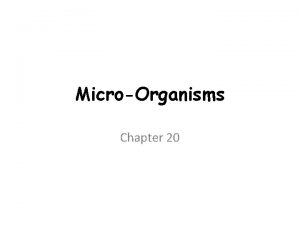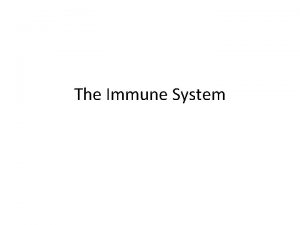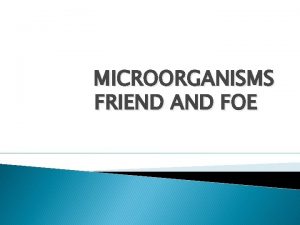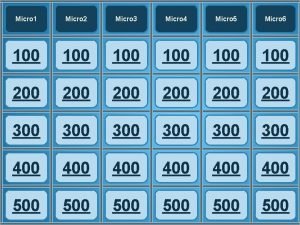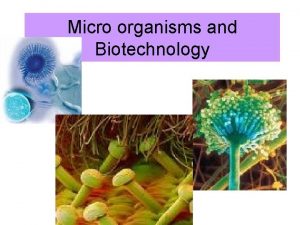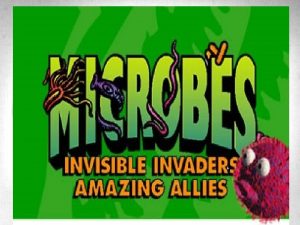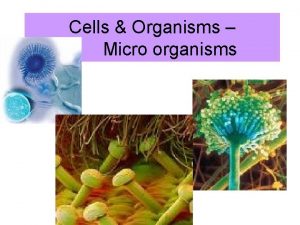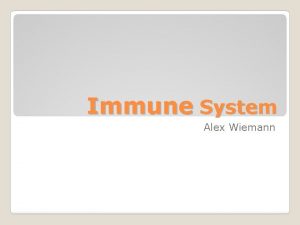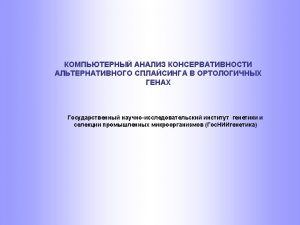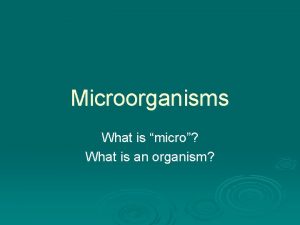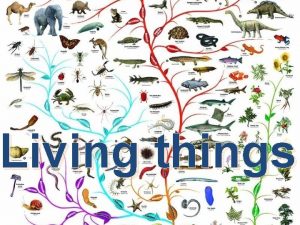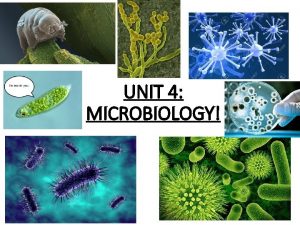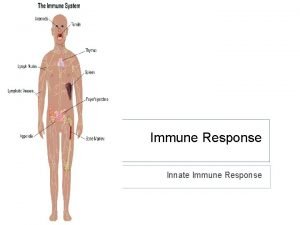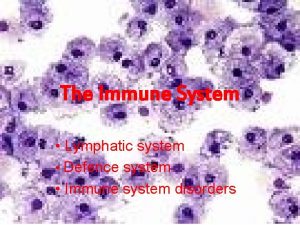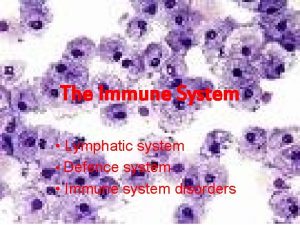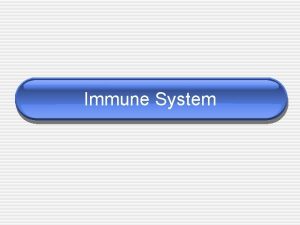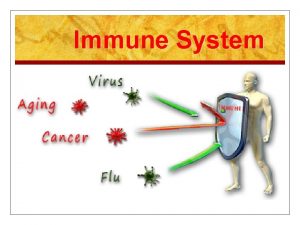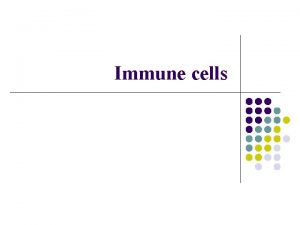THE IMMUNE SYSTEM Microorganisms Micro very small Organism




















































- Slides: 52

THE IMMUNE SYSTEM

Microorganisms Micro- very small Organism- a living thing. So Micro-organisms are very small living things! N. B Viruses are often classed as microorganisms but technically they are NON-Living so call them Microbes instead!

Microorganisms: The good side Decompose organic waste Are producers in the ecosystem by photosynthesis Produce industrial chemicals such as ethyl alcohol and acetone Produce fermented foods such as vinegar, cheese, and bread

Bacteria are small living single celled organisms that can come in good (beneficial) forms and bad (pathogenic) forms that cause disease. Some different shapes of bacteria

Bacteria divide and double in number every 20 minutes !!!

Bad bacteria in the mouth cause teeth to rot. Mouth bacteria Mouth bacterium

Viruses are extremely small (much smaller than bacteria) NON-LIVING microbes that need a host cell so that they can reproduce and survive.

Structure of viruses

Examples of viruses A T 4 bacteriophage. This infects only bacterial cells, in this case only E. coli The HIV virus. This attacks T 4 lymphocytes. It is responsible for AIDS.

Avian Flu Virus virus

Measles virus Electron microscope picture of the measles virus Boy with measles

Fungi are organisms that produce spores and come in the form of moulds, yeasts, mushrooms and toadstools. They also help things to rot and breakdown which is an essential process in the cycle of life.

Examples of fungi Mould growing a bread bun There can be good forms of fungus (used to make bread/beer) and bad forms (Mould, Athletes foot and thrush). Yeast cells budding

Athletes foot

Oral thrush Thrush yeast cells

Protozoa Eukaryotes Absorb or ingest organic chemicals May be motile via pseudopods, cilia, or flagella Figure 1. 1 c

Amoebiasis Entamoeba histolytica

Malaria

Link and Task!! http: //www. bbc. co. uk/schools/gcsebitesize/sc ience/edexcel/health/defendingagainstinfecti onrev 1. shtml Additional Information on Microbes

Koch’s Postulates A specific organism can always be found in association with a given disease The organism can be isolated and grown in pure culture in a laboratory The pure culture will produce the disease when inoculated into a susceptible animal It is possible to recover the organism in pure culture from the experimentally infected animal

Task !!

OUR IMMUNE SYSTEM

Skin and Mucous membranes in Defense http: //www. textbookofbacteriology. net/innat e_2. html information for mixed grouping

Cells of the Immune System White Blood Cells Phagocytes - Neutrophils - Macrophages Lymphocytes

Phagocytes Produced throughout life by the bone marrow. Scavengers – remove dead cells and microorganisms.

Neutrophils 60% of WBCs ‘Patrol tissues’ as they squeeze out of the capillaries. Large numbers are released during infections Short lived – die after digesting bacteria Dead neutrophils make up a large proportion of puss.

Macrophages Larger than neutrophils. Found in the organs, not the blood. Made in bone marrow as monocytes, called macrophages once they reach organs. Long life span Initiate immune responses as they display antigens from the pathogens to the lymphocytes.

Lymphocytes Produce antibodies B-cells mature in bone marrow then concentrate in lymph nodes and spleen T-cells mature in thymus B and T cells mature then circulate in the blood and lymph Circulation ensures they come into contact with pathogens and each other

T- T Lymphocytes Mature T-cells have T cell receptors which have a very similar structure to antibodies and are specific to 1 antigen. They are activated when the receptor comes into contact with the Ag with another host cell (e. g. on a macrophage membrane or an invaded body cell)

B -Lymphocytes There approx. 10 million different Blymphocytes, each of which make a different antibody. They are activated by chemical signals (CYTOKINES) secreted by the T cells

B -Lymphocytes Some activated B cells PLASMA CELLS these produce lots of antibodies, < 1000/sec The antibodies travel to the blood, lymph, lining of gut and lungs. The number of plasma cells goes down after a few weeks Antibodies stay in the blood longer but eventually their numbers go down too.

B -Lymphocytes Some activated B cells MEMORY CELLS. Memory cells divide rapidly as soon as the antigen is reintroduced. There are many more memory cells than there were clone cells. When the pathogen/infection infects again it is destroyed before any symptoms show.

B -Lymphocytes


How Abs work Some act as labels to identify antigens for phagocytes Some work as antitoxins i. e. they block toxins for e. g. those causing diphtheria and tetanus Some attach to bacterial flagella making them less active and easier for phagocytes to engulf Some cause agglutination (clumping together) of bacteria making them less likely to spread

Immune response Phagocyte ( Consumes Pathogen) Presents Ag to Specific T cell secretes Cytokines Specific B cells Activated Memory B Cell Plasma B Cell Rapid response Antibodies

Game on the immune system http: //nobelprize. org/educational/medicine/i mmunity/game/index. html

Task Time !! Report on AIDS What is it ? How does it spread? How does it affect the immune system? Preventive measures Design a brochure on AIDS awareness

Active and Passive Immunity Active immunity Lymphocytes are activated by antigens on the surface of pathogens Natural active immunity - acquired due to infection Artificial active immunity – vaccination Takes time for enough B and T cells to be produced to mount an effective response.

Active and Passive Immunity Passive immunity B and T cells are not activated and plasma cells have not produced antibodies. The antigen doesn’t have to be encountered for the body to make the antibodies. Antibodies appear immediately in blood but protection is only temporary.

Active and Passive Immunity Artificial passive immunity Used when a very rapid immune response is needed e. g. after infection with tetanus. Human antibodies are injected. In the case of tetanus these are antitoxin antibodies. Antibodies come from blood donors who have recently had the tetanus vaccination. Only provides short term protection as abs destroyed by phagocytes in spleen and liver.

Active and Passive Immunity Natural passive immunity A mother’s antibodies pass across the placenta to the foetus and remain for several months. Colostrum (the first breast milk) contains lots of Ig. A which remain on surface of the baby’s gut wall and pass into blood

Active and Passive Immunity Natural passive immunity A mother’s antibodies pass across the placenta to the foetus and remain for several months. Colostrum (the first breast milk) contains lots of Ig. A which remain on surface of the baby’s gut wall and pass into blood


Vaccination A preparation containing antigenic material: Whole live microorganism Dead microorganism Attenuated (harmless) microorganism Toxoid (harmless form of toxin) Preparation of harmless ags

Vaccination Why aren’t they always effective? Natural infections persist within the body for a long time so the immune system has time to develop an effective response, vaccinations from dead microbes do not do this. Less effective vaccines need booster injections to stimulate secondary responses Malnutrition particularly protein

Vaccination Why aren’t they always effective? No vaccines against protoctists (malaria and sleeping sickness) Many stages to Plasmodium life cycle with many antigens so vaccinations would have to be effective against all stages (or be effective just against infective stage but given in very small time period).

Allergies When the immune system responds to harmless substances Allergens – antigenic substances which do no real harm Allergens include house dust, animal skin, pollen, house dust mite and its faeces

Allergies Histamine causes blood vessels to widen and become leaky. Fluid and white blood cells leave capillaries. The area of leakage becomes hot, red and inflamed

Activity Role play on necessity of HPV vaccine

Task Prepare a Study on Asthma (3 -5 pages) What is it ? Is it contagious ? If yes, how? How is the body affected by it? What is the medication or cure for it ?

Summary and quiz http: //resources. schoolscience. co. uk/abpi/im mune/immune 2. html
 A subsequent
A subsequent Scientific notation rules
Scientific notation rules Food chain
Food chain Classification schemes of a fungus and a bacterium
Classification schemes of a fungus and a bacterium What is the third line of defense in the immune system
What is the third line of defense in the immune system Blood cells flow chart
Blood cells flow chart Any substance capable of provoking an immune response
Any substance capable of provoking an immune response Innate immunity first line of defense
Innate immunity first line of defense Chapter 35 immune system and disease
Chapter 35 immune system and disease What is the third line of defense in the immune system
What is the third line of defense in the immune system Ap bio immune system
Ap bio immune system Lesson 12 blood and immune system
Lesson 12 blood and immune system Lesson 12 blood and immune system
Lesson 12 blood and immune system Oobean
Oobean Types of antigen
Types of antigen Overreactions of the immune system
Overreactions of the immune system Lymphatic vs immune system
Lymphatic vs immune system Phagocitize
Phagocitize Defination of infection
Defination of infection Third line of defense
Third line of defense What is the main function of the immune system
What is the main function of the immune system Malt
Malt Thymus immune system
Thymus immune system Immune complex
Immune complex Thalassemia facies
Thalassemia facies 1what's the purpose of the body's immune system?
1what's the purpose of the body's immune system? Very bad to very good scale
Very bad to very good scale Fewfewfewf
Fewfewfewf It is a very shallow skillet with very short sloping sides
It is a very shallow skillet with very short sloping sides Quantifiers for milk
Quantifiers for milk Small areas of white used to show the very brightest spots
Small areas of white used to show the very brightest spots Sistema solar
Sistema solar Atoms are very small
Atoms are very small Macro meaning
Macro meaning Micro cottage and small industry promotion center
Micro cottage and small industry promotion center Learning objectives of microorganisms
Learning objectives of microorganisms Harmful microorganisms
Harmful microorganisms Harmful microorganisms
Harmful microorganisms The five i's of studying microorganisms
The five i's of studying microorganisms Flora ir fauna
Flora ir fauna What are intrinsic factors for microbial growth
What are intrinsic factors for microbial growth Observing microorganisms through a microscope
Observing microorganisms through a microscope Microorganisms meaning
Microorganisms meaning Microorganisms 5th grade
Microorganisms 5th grade Organism
Organism Fermentation in microorganisms
Fermentation in microorganisms Most wanted bacteria poster
Most wanted bacteria poster What is microbiology
What is microbiology Classification of microorganisms
Classification of microorganisms Microorganisms
Microorganisms What is the microorganisms
What is the microorganisms Physiology of microorganisms
Physiology of microorganisms Gammaproteobacteria dichotomous key
Gammaproteobacteria dichotomous key



